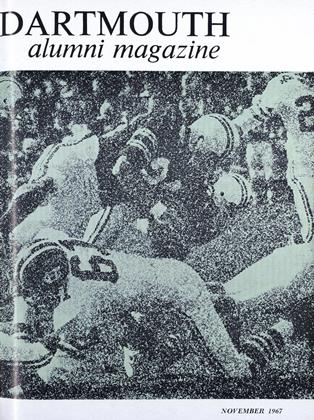Dr. Michael S. Gazzaniga '61 is the source of a recent New York Times feature relating how one-half of the human brain can operate independently of the other. Dr. Gazzaniga has further described his findings in the August issue of Scientific American.
A psychologist at the University of California at Santa Barbara, Dr. Gazzaniga conducted visual experiments with patients whose brain hemispheres' connecting nerves had been surgically separated to ease the effects of epilepsy. Some of these patients experienced no change in intelligence or personality; others showed that each brain hemisphere may even have separate thoughts and emotions.
Because stimuli to the left side of the human body are processed by the brain's right side and vice versa, interaction of the two halves could be observed. A light flashed to the left side of the field of vision, for example, is processed by the right brain half. However the control of speech is located in the left brain half and, although the right hemisphere knew what it had seen, it could not describe it because it was severed from the speech center. An individual knew what he had seen although he could not say so: when shown a picture of a spoon in his left field of vision, he chose a spoon from among several articles before him.
Dr. Gazzaniga has conducted his experiments over the past five years in collaboration with another scientist at the California Institute of Technology. The results, says The Times, "are providing new insights into how the human brain works."
 View Full Issue
View Full Issue
More From This Issue
-
 Feature
FeatureA Fulbright Professor in France
November 1967 By FRANCIS E. MERRILL '26, -
 Feature
FeatureMt. McKinley Conquered
November 1967 By Anthony H. Horan '61 -
 Feature
FeatureFINAL REPORT 1966-1967
November 1967 By RALPH LAZARUS '35 -
 Feature
FeatureTHE BETRAYAL OF IDEALISM
November 1967 -
 Feature
FeatureThe Topic: Third Century Fund
November 1967 -
 Article
ArticleWith tine Big Green Teams
November 1967
Article
-
 Article
ArticleSickness in Hanover Dick's House Full
FEBRUARY 1929 -
 Article
ArticleFund Gifts from Old Guard
March 1938 -
 Article
ArticleAn Urban Study
January 1960 -
 Article
ArticleFace to Watch
Nov/Dec 2002 -
 Article
ArticleTuck School
March 1951 By H. L. DUNCOMBE JR. K. A. HILL -
 Article
ArticlePittsburgh
February 1960 By NATHAN K. PARKER JR. '52

